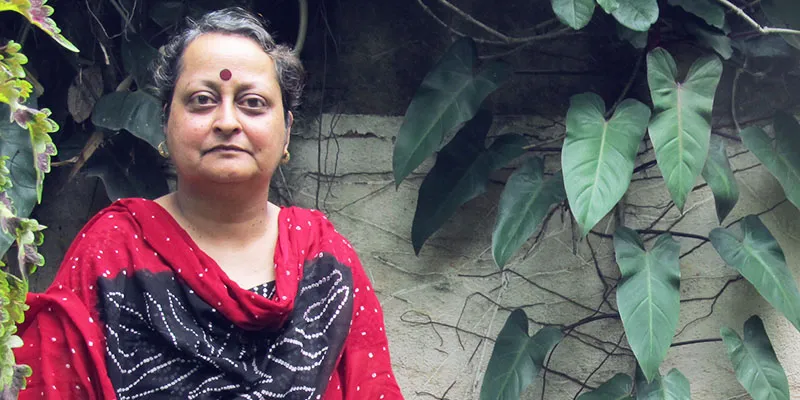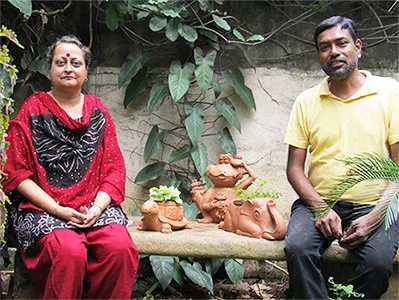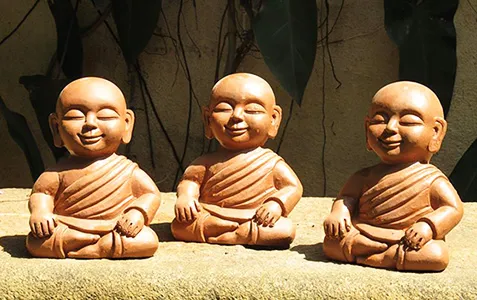Maati: Firing up terracotta artefacts to keep the potters’ kitchen fire burning
There are just a handful of places left in Bangalore that have a suburban feel to them – wide, tree lined avenues, streets covered with windswept leaves, and houses on larger plots with a garden in the front welcoming you; perhaps, for a cup of traditional south Indian filter coffee. One such neighbourhood is Jayanagar, 1st Block, Bangalore, near Ashok Pillar (though the symbols of city sprawl have inveigled their way in – bus routes, shopping arcades, kalyana mantapas, and coffee franchises).

In this relatively quiet neighbourhood abutting the south gate of Lalbagh Gardens, lives the quiet and unassuming, Shashi Bagchi. She has a small two-storied house with a quaint triangular garden, and a few trees hugging the perimeter of the house – mango, coconut and few other flowering varieties.
Shashi developed a love for gardening from her father. She avidly tends to her garden and can be seen constantly pottering around and watering them. Many of the plants are in terracotta pots of various shapes and all of them have been made by ‘Maati’ – a terracotta store (and now a brand) she owns.
Shashi says, “When I started gardening I went in search of terracotta pots in the market, and was very disappointed. The market was flooded with cement and plastic pots; they are not healthy for plants because these materials do not ‘breathe’ due to the lack of porosity. The few terracotta pots that were available by the roadside lacked both aesthetics and quality. So, I decided to make them myself. I enrolled in a design school and learnt the art of pottery making. Then I went in search of potters who would work on my designs, and according to my specifications.”
The ‘potters’ of Bangalore
Bangalore has a relatively rich history of terracotta. The rich red soil of the Deccan plateau lends itself to terracotta (which, literally, means baked mud) making. Bangalore always had dedicated potters; so much so that there is a place called ‘Pottery Town’ which is tucked away behind the serpentine lanes of ‘Pottery Road’. She found her way there to talk to some of the potters but was in for quite a shock. She discovered that she was probably talking to the last generation of potters (their trade having been ravaged by the advent of modernity – in the form of plastics, concrete and sheet metal). From the original families of potters, just a handful remains – struggling to keep their art alive, not to mention their kitchen fires. Most of them lack education and are practising only the basic skills to produce very basic products. They lack infrastructure, and are marginalised by the trade; they don’t even get the fair market value for what they produce. Besides, since the market demands the same set of products repetitively, their skill levels are slowly on the wane. In this situation, potter families do not encourage their children to learn the art, which unfortunately has become a symbol of deprivation and poverty. Shashi was not only appalled at their plight; but also at the demise of terracotta as an art form.
A bit of terracotta history
We can only reminisce through the pages of history: the Greeks, as early as in the 7th Century BC, used terracotta to erect statues in homage to their gods, make terracotta jewellery and trinkets to adorn their women, and make small terracotta seals and tablets as symbols of trade and authority.

One can only gape in wonder at the ‘The Eternal Army’ – thousands of life-size terracotta soldiers and horses were interred along with the first self-proclaimed Chinese Emperor, Qin Shi Huangdi (he was crowned Emperor in 221 BC).
Closer home, beautiful figurines, vessels, personal accoutrements, trade symbols, and a world famous sewage system, all in terracotta, have been found in the archaeological remains of the Indus Valley Civilization.
With such a rich past, it is indeed sad to see the fate that has befallen the simple and elegant art of terracotta craftsmanship.
Working for social uplift
Shashi, who is also a painter and a craftsperson, decided to do something about the situation; albeit in a small way. The plight of the potters became her inspiration and she worked hard to arrive at a solution. She soon started a store called Maati, in her own front yard, and began designing all the products that are sold there. It took her over two years of research and handholding to get potters who could deliver the kinds of products she wanted. She now has a dedicated team of three potters (and a few more, on a need basis) who are fully trained and help her in commercialising her production. She ensures that the potters are paid well, and even pays them in advance, so that they are not affected by the sales cycle. It’s about eight years since Maati started doing business, and it is now a leading brand name in terracotta products in the south.
The products
Contrary to popular belief, terracotta products can be quite durable – it depends on the mud and clay used, and the high temperature maintained during the baking process. Shashi’s exclusive designs, and the craftsmanship of the potters, have helped establish Maati as the premier brand in the city.
While it’s not quite the Chinese ‘eternal army’ as yet, Maati has an impressive array of garden, wall and home decor products: large planters, garden urns, animal shaped planters, themed planters, bird baths, bird feeds, bird houses, garden ornaments, lamp/lampshades, chandeliers, wall murals, masks and home decor items. Besides these, Maati does custom installations of murals, picture frames and other artefacts.
“Decorative and themed terracotta products elevate the overall aesthetics of any room, deck, balcony or garden. Animal shaped or object inspired shapes like textured baskets, shells, mushrooms, cups and saucers, and elves and gargoyles bring elegance and beauty into any space; and smile to your face,” says Shashi, with a flash of radiance of her own.
The next time you visit the store: look out for dogs that have their tails up and their snouts buried in the ground (chasing moles and rabbits, I presume); bird feeds which seek the company of early-morning sparrows; a family of ducks lying about in the grass; and tall, silent, elegant, garden urns, standing sentinel over the myriad products in the wide-open Maati store.
The market and competition
The Bangalore market is full of relatively low-quality products made from plastic, stone, concrete, sheet metal and cheaper grade terracotta. There is no real competition for Maati which has much superior products, both in design and finish. So much so, that Maati has become a market leader, and is even getting orders from as far away as Coimbatore and Chennai.
At present, Maati sells over 10,000 planters a year, besides other artefacts. The market is growing rapidly and there is a burgeoning demand for quality terracotta products. Anin, Shashi’s husband, who is at present, handling the business side of things, says, “We are planning to open another store in Bangalore, preferably in the Whitefield area, but we don’t quite know when. We also need to be in Tier 1 cities like

Pune, Coimbatore and Mysore, but those will have to wait for a little more time. Ramping up production is a big factor; there isn’t enough skilled labour available, and the transportation costs are prohibitive. We will, of course, have to train many more potters, but that again, is something that we want to do anyway.” When quizzed about online sales, Anin responds, “The fragility of terracotta and the innate weight of mud make it a difficult proposition. We are contemplating designing some items that are light in weight for easy shipping, but showcasing (and delivering) the entire range seems to be difficult. We are looking at ways to overcome this. Maybe the boost, in recent times, in hyperlocal delivery mechanisms might provide us with an answer.”The Clients
Shashi claims that anyone who has bought a product from Maati has almost always become a repeat buyer. Both, she and Anin, are busy right through the weekends attending to customers at their Jayanagar (home) store. Anin says, “People come from all over town; some as far as Whitefield. Both Shashi, and Maati, have been featured in lifestyle magazines, national dailies, and local TV channels, and the publicity has allowed the business to gain a lot of traction. Furthermore, participating in exhibitions like ‘Sunday Soul Sante’, ‘Hundred Hands’, etc., has made Maati a popular local brand. And, yes, we are on Facebook.”
Maati has quite a few marquee clients. Arati Kirloskar [for her residence in Pune], Bangalore International Exhibition Centre (BIEC), Oberoi Hotels, Movenpick Hotel and Spa, Angsana Spa, Sri Krishna Hospital, Ritz-Carlton, Park Hotel, Windsor Manor Sheraton, to name a few.
The road ahead
The future is bright and quality terracotta products are making a comeback. Maati is now poised for bigger things. Shashi is very happy that her quest to help the potters is somewhat fulfilled, though, much still remains to be done.







